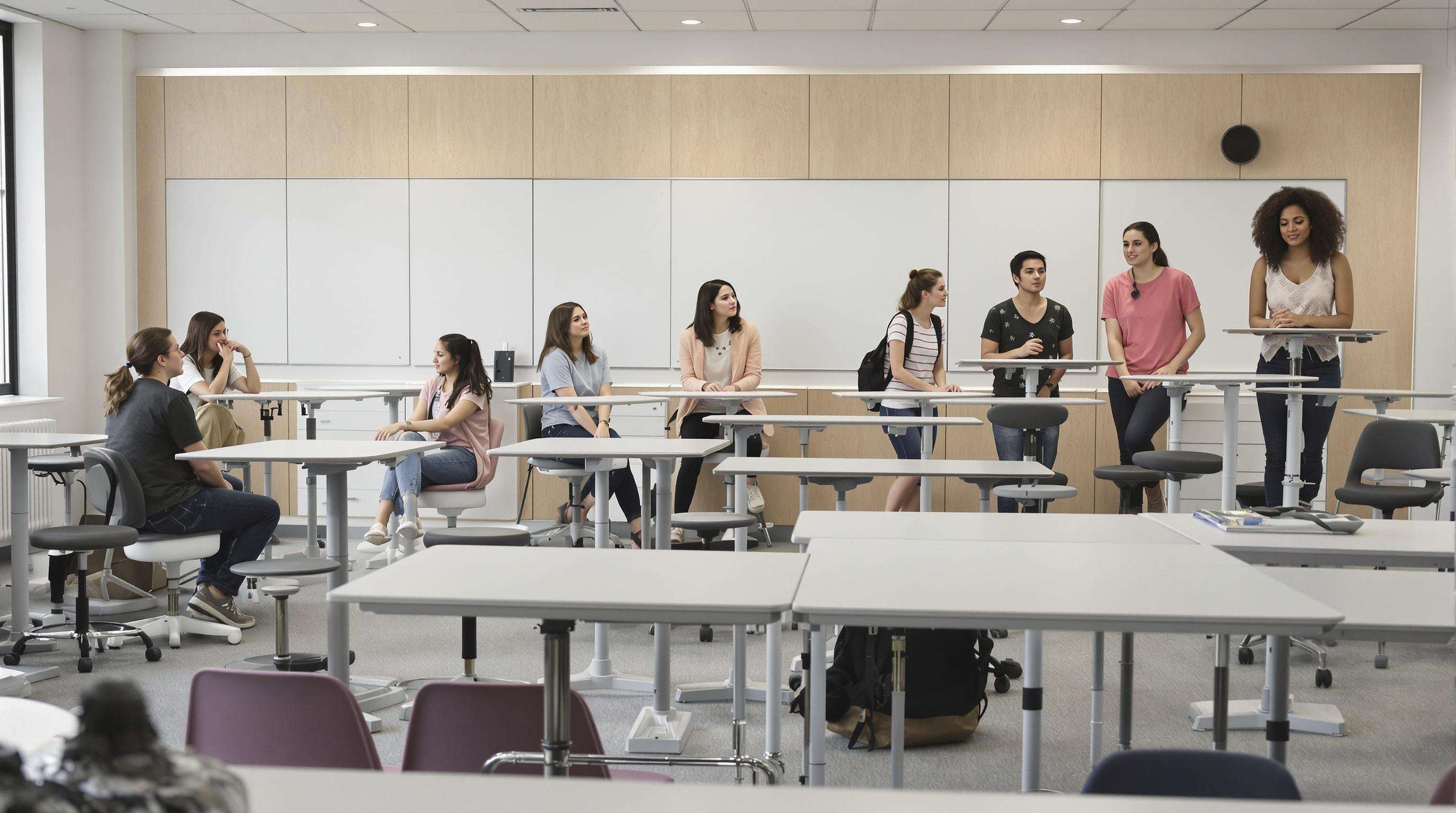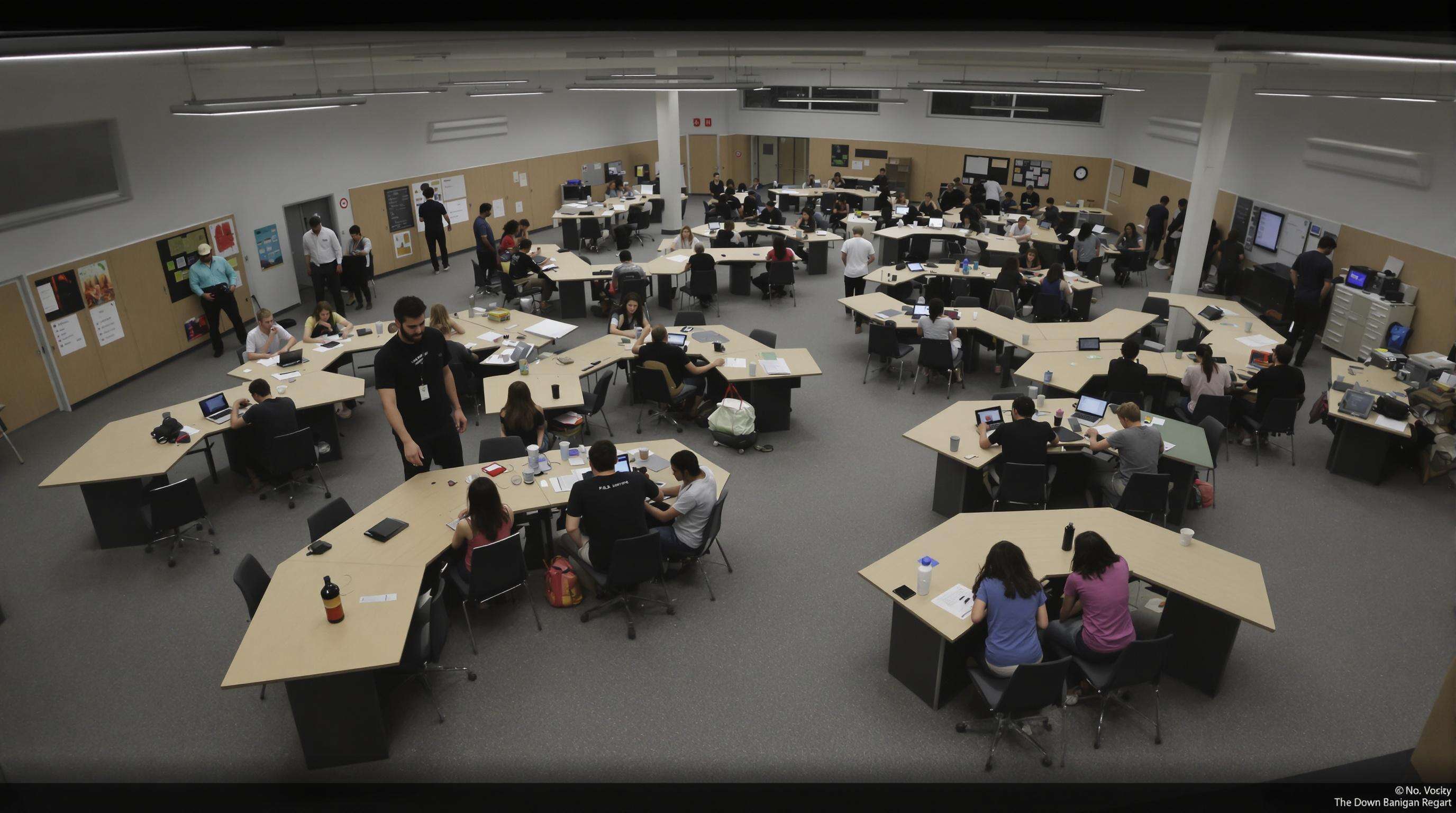Supporting Active Learning Pedagogy Through Student Desk Design
Understanding active learning pedagogy and its spatial requirements
When we talk about active learning, what we really mean is getting kids out of their seats and into the action instead of just sitting there taking notes. Good classrooms need to handle all sorts of different teaching styles throughout the day. Sometimes it's a regular lesson, other times students work together in small groups, and occasionally they need space to tackle projects on their own. The way the room looks matters a lot too. Kids should be able to move things around depending on what they're doing whether it's setting up for a science experiment or staging a debate about history. Those old fashioned rows of desks with 30 chairs bolted down? Not so great for learning anymore. Modern setups with movable tables and chairs let students collaborate whenever inspiration strikes and create spaces that actually match how they learn best.
How student-centered pedagogy influences classroom furniture choices
When it comes to teaching focused on students, the furniture matters a lot. We need pieces that let kids take control and rearrange things as needed. Desks that aren't too heavy (around 10-20 pounds usually works) with wheels make all the difference for students setting up their spots when working on projects together. Some schools are going with trapezoid shaped desks which fit together nicely in groups of six for giving each other feedback. Others prefer the old fashioned horseshoe setup where everyone can see the teacher and talk back and forth easily. These layouts actually change how classes feel compared to those boring rectangular tables everyone just sits at facing forward. Teachers end up walking around more, helping out here and there instead of standing at the front talking at students for hours on end.
The impact of student desks on active learning strategies
A University of Minnesota (2022) study found that classrooms with mobile desks saw a 73% increase in collaborative problem-solving compared to fixed setups. Adjustable-height models support standing brainstorming sessions, and flip-up surfaces double as presentation stations. These features directly support key active learning techniques:
- Think-Pair-Share — Desks pivot into face-to-face pairs in seconds
- Jigsaw Method — Rolling clusters merge and split for expert group rotations
- Peer Review — U-shaped layouts enhance eye contact and feedback quality
- Gallery Walks — Lightweight desks form mobile exhibition circles
Case study: Redesigning a middle school classroom with modular student desks
Riverside Middle School replaced 28 fixed desks with 24 mobile units equipped with folding whiteboards and device charging ports. Teachers now reconfigure the room 6–8 times daily for different subjects:
- Science — Lab-style rows for experiments shift to analysis pods
- History — Debate circles transform into research nooks
- Math — Stadium seating for instruction becomes peer tutoring pairs
Within one semester, group task completion rose by 40%, and transition time dropped by 15 minutes per class. The adaptability of the modular desks also improved differentiated instruction, allowing rapid adjustments for both advanced learners and those needing extra support.
Enhancing Student Engagement with Flexible and Ergonomic Student Desks

Defining flexible seating and its psychological benefits for learners
When classrooms offer flexible seating arrangements, students get to pick spots that fit how they learn best, which gives them a real sense of control over their environment. Schools are starting to see benefits from letting kids use standing desks, those bouncy wobble stools, or even just working on the floor with some mats. Research published in the Journal of Educational Psychology back in 2021 found groups using these varied setups actually worked together better, showing around 23 percent improvement in teamwork during projects. The ability to move around while studying seems to make a big difference too. Teachers notice students stay focused longer when they can adjust where they sit throughout the day rather than being stuck at traditional desks all period.
Ergonomic variety in student desks: Supporting diverse physical and cognitive needs
Today's student desks are designed to work better for all kinds of learners. They come with adjustable surfaces that can tilt at around 14 degrees, heavy duty wheels that roll smoothly across floors, and several different height settings so everyone can find their sweet spot. Kids who learn best through touch really appreciate the special textured edges where they can keep their fidget tools handy. For those who think visually, there are built-in whiteboard sections right at desk level. Research from Stanford back in 2022 showed something pretty interesting too. Classrooms where students could choose between standing or sitting saw a big drop in reported back pain – down by about two thirds actually. And teachers noticed something else as well. Students stayed focused on their lessons nearly 18 percent longer when given this flexibility.
Data insight: 73% increase in on-task behavior with flexible student desks (University of Minnesota, 2022)
The University of Minnesota’s 18-month study tracked 1,400 middle schoolers across 24 classrooms. Those using height-adjustable desks with flip-top surfaces showed significant gains:
| Metric | Improvement |
|---|---|
| On-task behavior | +73% |
| Peer-to-peer mentoring | +58% |
| Knowledge retention | +42% |
These improvements were consistent across socioeconomic groups, with ADHD-diagnosed students showing the highest engagement increase (+81%). Researchers attribute this to micro-movements sustained by ergonomic furniture, which support blood flow to the prefrontal cortex.
Designing Collaborative and Multi-Purpose Classroom Layouts with Student Desks

Optimizing Group Dynamics Through Collaborative Desk Arrangements
Trapezoidal and hexagonal desk shapes naturally encourage face-to-face interaction, boosting idea-sharing efficiency by 40% compared to traditional rows (Educational Design Journal, 2023). Clustered layouts eliminate "social blind spots," ensuring all students participate equally in group tasks. Teachers report more balanced contributions and fewer dominance imbalances in discussion-based activities.
Modular and Mobile Student Desks for Rapid Classroom Reconfiguration
Classrooms today need furniture that adapts instantly to changing instructional needs. Desks with industrial-grade casters allow teachers to shift from Socratic seminars to lab stations in under 90 seconds. This agility supports differentiated instruction, where spatial flexibility correlates with 58% higher lesson plan adherence.
Case Study: Transforming a High School Science Lab with Collaborative Student Desks
A STEM-focused high school replaced fixed lab tables with height-adjustable desks featuring built-in power outlets and rotating work surfaces. Over six months, group project completion increased by 32%, and equipment spills dropped by 67% due to improved sightlines and ergonomic access.
Supporting Hybrid Learning: Desks That Transition Between Lecture, Teamwork, and Independent Work
Hybrid-ready desks integrate multiple functions: flip-up privacy panels for individual assessments, magnetic side surfaces for group whiteboarding, and undercarriage storage for seamless mode switching. A 2023 district-wide pilot found this tri-modal design reduced daily transition waste by 24 minutes.
Promoting Inclusivity and Focus Through Strategic Student Desk Selection
Inclusive Learning Environment Principles and Their Impact on Desk Design Choices
Inclusive classrooms require desks that support accessibility and equity. Adaptable furniture configurations reduce spatial barriers by 42% for students with mobility challenges. Multi-height desks and rounded edges accommodate diverse body types and promote peer interaction, aligning with principles of Universal Design for Learning (UDL).
Accommodating Neurodiverse and Physically Diverse Learners With Adaptive Student Desks
Adjustable desks with tilt surfaces and split-level workspaces help students with ADHD or dyslexia self-regulate during tasks. For wheelchair users, desks with 28"–34" clearance and mobile pedestals ensure smooth transitions between activities. These features support sensory regulation and physical access without singling out individual needs.
Maximizing Focus: Desk Arrangements That Balance Visibility, Acoustics, and Movement
Placing desks in 5–7 foot pods with 120° sightlines to whiteboards improves on-task behavior. Angled trapezoid desks reduce auditory distractions by 31% compared to straight rows. Standing desks paired with anti-fatigue mats further support kinesthetic learners, allowing movement without disruption.
Strategy Guide: Rotating Student Desk Configurations to Sustain Engagement
A 6-week trial in urban middle schools found that rotating layouts every 8 school days maintained 89% student participation. Teachers alternated between:
- U-shaped formations for class discussions
- Dynamic duos (paired desks on casters) for peer review
- Solo focus stations with privacy screens
This rotation prevents spatial monotony and aligns with evolving lesson goals.
Evaluating the ROI of Flexible Learning Spaces and Student Desk Investments
Industry Paradox: Upfront Cost vs. Long-Term Educational and Operational ROI
Many school admins balk at the initial price tag for flexible desks, which typically run anywhere from $450 to $800 each, while standard desks usually cost between $200 and $400. But when looking at the big picture, these desks actually make financial sense in the long run. According to the 2023 Education Facility ROI Report, classrooms equipped with modular desks saw about 1.6 times better results in student performance after five years, plus they saved around 34% on yearly maintenance expenses. What's more, these adaptable learning environments can adjust to new teaching approaches roughly 72% quicker than traditional setups, meaning schools don't have to spend extra money on costly renovations down the road.
Operationally, schools using reconfigurable desks reported 22% lower energy expenditures, thanks to better space utilization and reduced need for auxiliary rooms. When educational gains and operational savings are combined, the investment in flexible student desks delivers measurable returns in both student success and institutional sustainability.
FAQ Section
What is active learning pedagogy?
Active learning pedagogy involves engaging students in the learning process by encouraging them to interact, discuss, and collaborate rather than passive note-taking.
How do modular student desks support active learning?
Modular student desks allow for flexible arrangements that facilitate collaboration, group activities, and individualized learning, enhancing the active learning environment.
What are the advantages of ergonomic desks for students?
Ergonomic desks support diverse learners by allowing adjustments in height and angle, improving comfort, focus, and potentially reducing physical discomfort.
Why should schools consider investing in flexible student desks?
Investing in flexible student desks can result in improved student performance, lower long-term maintenance costs, and greater adaptability to evolving teaching methods.
Table of Contents
- Supporting Active Learning Pedagogy Through Student Desk Design
- Enhancing Student Engagement with Flexible and Ergonomic Student Desks
-
Designing Collaborative and Multi-Purpose Classroom Layouts with Student Desks
- Optimizing Group Dynamics Through Collaborative Desk Arrangements
- Modular and Mobile Student Desks for Rapid Classroom Reconfiguration
- Case Study: Transforming a High School Science Lab with Collaborative Student Desks
- Supporting Hybrid Learning: Desks That Transition Between Lecture, Teamwork, and Independent Work
-
Promoting Inclusivity and Focus Through Strategic Student Desk Selection
- Inclusive Learning Environment Principles and Their Impact on Desk Design Choices
- Accommodating Neurodiverse and Physically Diverse Learners With Adaptive Student Desks
- Maximizing Focus: Desk Arrangements That Balance Visibility, Acoustics, and Movement
- Strategy Guide: Rotating Student Desk Configurations to Sustain Engagement
- Evaluating the ROI of Flexible Learning Spaces and Student Desk Investments
- FAQ Section


